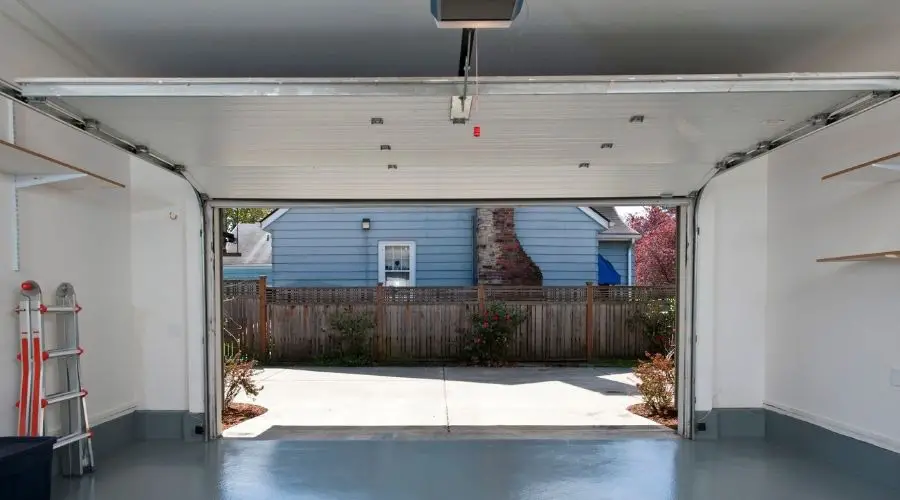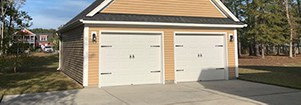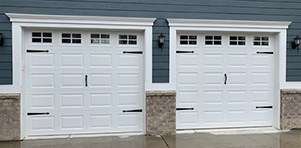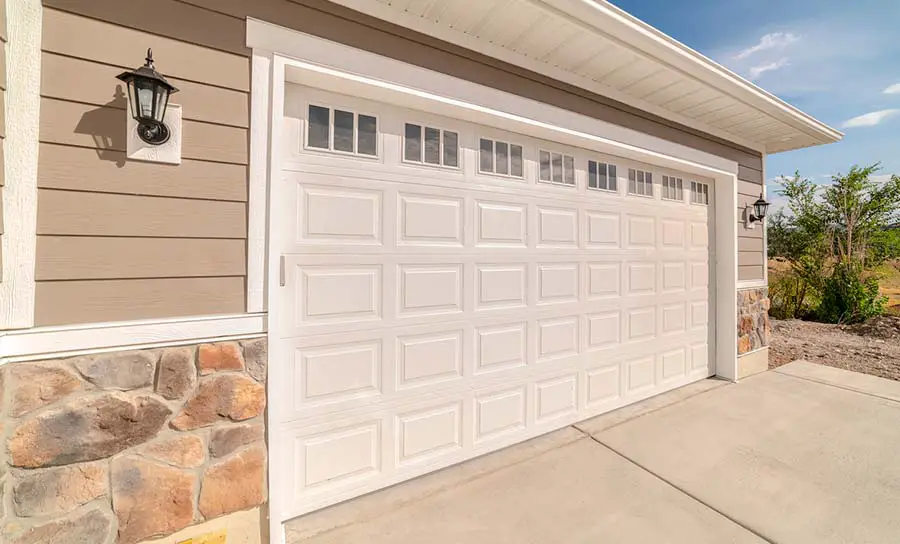
Having a garage is a luxury because it protects your home and provides numerous storage spaces for your belongings within your home.
You might be considering adding one to your home and making it official because of how many benefits it adds.
However, you need to know quite a few things about a garage, such as the different types, styles, and how much a garage door weighs. So, what is the answer to the weight of a garage door?
The average modern steel garage door typically weighs around 125 pounds for a single garage door and roughly 200 pounds for a double garage door. Some wood garage doors can exceed 300 pounds.
The garage door weight depends on what material you use, size, thickness, insulation, glass, and steel gauge.
garage door openers have weight limits, so it’s important to know the garage door weight to choose garage door springs and an opener that can efficiently operate the door.
You might be wondering why the weight of the door matters in the first place and why you should care. If you are putting a garage up in your home, you must be considerate of certain things, and this is one of those instances.
We will discuss many important subjects in this article, to keep reading to find out more.
How Much Does a Garage Door Weigh?
The garage door spring systems consist of either torsion springs or extension springs that counterbalance the garage door weight.
- If you have torsion springs you’ll have a large spring around a steel shaft located above the garage door on the front wall.
- If you have two springs with pulleys and cables along the horizontal tracks suspended from the ceiling, these are the extension springs.
An average garage door weighs roughly 125 pounds for a single steel door. However, another standard garage used is a double-door. In that case, you are looking at about 200 pounds if it is steel.
However, this does not consider if you want another type of garage door, such as wood. In that case, we will need to look a bit deeper into the subject. This is especially true since you have to determine the weight by a few factors:
- The material you use.
- The size you wish the door to be (1, 2, 3, or 4 door.)
- The size you want (if you wish to have a 3 to 4 car garage, the weight will drastically increase.)
- What thickness or steel gauge do you wish the garage door to be (most doors are between 24 to 26 gauge steel. If you go higher in number, the steel gets thinner, and the lower the number, the thicker the steel door is.)
- If you wish to put insulation on the door itself.
- If you wish to put a glass on the door (if you have older wooden doors with full vision glass, or overlay, it will weigh much more than a basic steel door.)
Given that information at hand, why is the door weight so crucial in the first place? Because you have to find out what type of torsion springs is required to counterbalance the garage door’s weight correctly.
We have provided a chart below for easy understanding. The graph mentioned below is for a solid garage door with 25-gauge steel, 14-gauge hardware, and one strut per door.
| Width & Height | Non-insulated | Vinyl backed insulated | Double-sided steel (1 3/8″ thick) | Double-sided steel (2″ thick) |
|---|---|---|---|---|
| 8×7 | 80 pounds | 88 pounds | 95 pounds | 115 pounds |
| 9×7 | 85 pounds | 95 pounds | 105 pounds | 129 pounds |
| 10×7 | 98 pounds | 108 pounds | 115 pounds | 142 pounds |
| 12×7 | 112 pounds | 125 pounds | 135 pounds | 169 pounds |
| 14×7 | 135 pounds | 150 pounds | 162 pounds | 195 pounds |
| 16×7 | 155 pounds | 170 pounds | 182 pounds | 220 pounds |
| 18×7 | 177 pounds | 194 pounds | 204 pounds | 252 pounds |
| 8×8 | 90 pounds | 100 pounds | 108 pounds | 133 pounds |
| 9×8 | 95 pounds | 110 pounds | 120 pounds | 148 pounds |
| 10×8 | 113 pounds | 125 pounds | 132 pounds | 165 pounds |
| 12×8 | 130 pounds | 145 pounds | 155 pounds | 195 pounds |
| 14×8 | 153 pounds | 170 pounds | 185 pounds | 224 pounds |
| 16×8 | 185 pounds | 205 pounds | 209 pounds | 253 pounds |
| 18×8 | 225 pounds | 236 pounds | 239 pounds | 281 pounds |
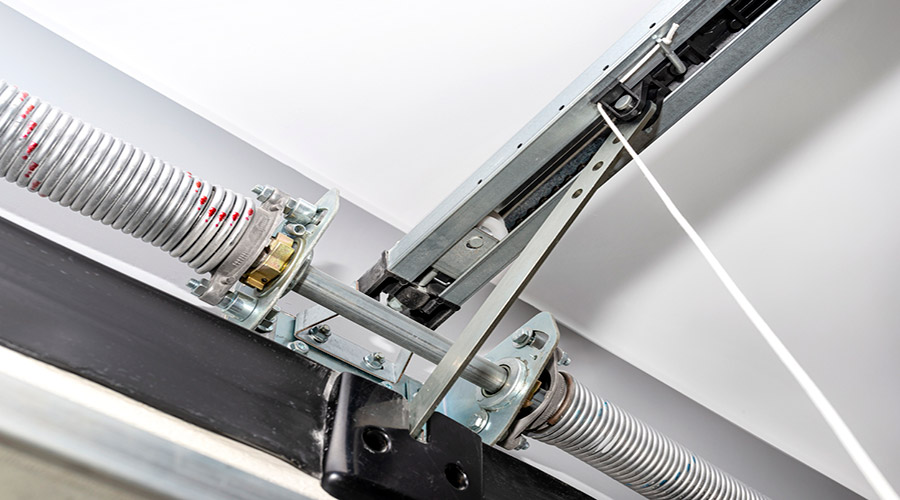
What Torsion Springs Would I Need for My Garage Door?
As you know, the weight is essential to know because it helps you determine what torsion spring you will need. Before we go on to any other subject, we must discuss this.
Suppose you have a 12×7 non-insulated garage door that weighs 112 pounds.
In that case, you will need a different-sized torsion spring for a 16×8 double-sided steel insulated door that weighs 253 pounds.
You also need to take other things into account as well. These preferences include the following:
- Durability
- Upkeep
- Safety
- Budget
- Appearance
- Door design
- The material used
Knowing all of this, you can ask a professional for their help or find out the one you need on your own. There are other things to take into consideration:
1. The Direction of the Wind
If you have a newer garage, then you’ll have two torsion springs attached to it. They must turn a specific direction to lower and lift the garage door in itself, which would be either clockwise or counterclockwise.
When it turns clockwise, it goes towards the left wind, but the springs will go right wind for counterclockwise.
The garage door from inside will seem like the right-wound spring is on the left, but this is not the case.
2. The Overall Length
If you have a torsion spring that is smaller than the size it needs to be, then it cannot lift the door.
It is especially true since the length of the spring itself determines the winding capacity.
If you wish to measure the length’s accuracy, do not keep the garage door open at all. Always make sure that it is closed before measuring.
3. Inside Diameter
In most cases, you can find the diameter in inches between the two springs above the door panel on the stationary cone. The measurement is required because it helps the springs fit into the space and produces the force used.
You can also measure the diameter by having a professional remove the springs.
4. Wire Size
If you wish to determine what wire thickness you will need, measure the distance between 10 and 20 coils to the nearest 1/16th of an inch.
Note: Never touch the springs on the bars above the doors.
Once you have the thickness, refer to this chart for what wire size you need.
However, it is always wise to leave the installation to the experts, especially if you lack knowledge in this area.
| 10-coil Measurement | 20-coil measurement | Wire Size | ||
|---|---|---|---|---|
| Inches | Centimeters | Inches | Centimeters | |
| 1-3/4″ | 4.5 | 3-1/2″ | 8.99 | 0.177 |
| 1-7/8″ | 4.76 | 3-3/4″ | 9.53 | 0.1875 |
| 1-15/16″ | 4.88 | 3-7/8″ | 9.75 | 0.192 |
| 2″ | 5.08 | 4″ | 10.16 | 0.2 |
| 2-1/16″ | 5.26 | 4-1/8″ | 10.52 | 0.207 |
| 2-3/16″ | 5.55 | 4-3/8″ | 11.11 | 0.2187 |
| 2-1/4″ | 5.72 | 4-1/2″ | 11.45 | 0.2253 |
| 2-3/8″ | 5.95 | 4-11/16″ | 11.9 | 0.2343 |
| 2-3/8″ | 6.02 | 4-3/4″ | 12.04 | 0.2375 |
| 2-7/16″ | 6.19 | 4-7/8″ | 12.38 | 0.2437 |
| 2-1/2″ | 6.35 | 5″ | 12.7 | 0.25 |
| 2-5/8″ | 6.67 | 5-1/4″ | 13.34 | 0.2625 |
| 2-3/4″ | 6.93 | 5-1/2″ | 13.87 | 0.273 |
| 2-13/16″ | 7.19 | 5-5/8″ | 14.38 | 0.283 |
| 2-7/8″ | 7.34 | 5-3/4″ | 14.68 | 0.289 |
| 2-15/16″ | 7.49 | 5-7/8″ | 14.99 | 0.295 |
| 3-1/16″ | 7.79 | 6-1/8″ | 15.57 | 0.3065 |
| 3-1/8″ | 7.94 | 6-1/4″ | 15.88 | 0.3125 |
| 3-3/16″ | 8.12 | 6-3/8″ | 16.23 | 0.3195 |
| 3-5/16″ | 8.41 | 6-5/8″ | 16.81 | 0.331 |
| 3-7/16″ | 8.73 | 6-7/8″ | 17.46 | 0.3437 |
| 3-5/8″ | 9.21 | 7-1/4″ | 18.42 | 0.3625 |
| 3-3/4″ | 9.53 | 7-1/2″ | 19.05 | 0.375 |
| 3-15/16″ | 10 | 7-7/8″ | 20.01 | 0.3938 |
| 4-1/16″ | 10.32 | 8-1/8″ | 20.63 | 0.4062 |
| 4-7/32″ | 10.71 | 8-7/16″ | 21.43 | 0.4218 |
| 4-5/16″ | 10.93 | 8-5/8″ | 21.87 | 0.4305 |
| 4-3/8″ | 11.11 | 8-3/4″ | 22.23 | 0.4375 |
| 4-17/32″ | 11.51 | 9-1/16″ | 23.02 | 0.4531 |
| 4-5/8″ | 11.72 | 9-1/4″ | 23.44 | 0.4615 |
| 4-11/16″ | 11.9 | 9-3/8″ | 23.81 | 0.4687 |
| 4-7/8″ | 12.45 | 9-3/4″ | 24.89 | 0.49 |
| 5″ | 12.7 | 10″ | 25.4 | 0.5 |
| 5-5/16″ | 13.49 | 10-5/8″ | 26.98 | 0.5312 |
| 5-5/8″ | 14.29 | 11-1/4″ | 28.58 | 0.5625 |
| 6-1/4″ | 15.88 | 12-1/2″ | 31.75 | 0.625 |

What Are the Different Styles of Garage Doors?
1. Roll-up Garage Door
A roll-up garage door will be your most common one out there. Most households with garage doors tend to allow them to roll up to the ceiling aside from anywhere else.
You will not have to worry about the door taking up any space within your garage, especially since it is already up to the ceiling. However, if you have limited ceiling space, this might not be the best option for you.
2. Side-to-side Garage Door
As says the name, you can choose to have a door that goes side-to-side. The entry in itself will sit parallel to the wall, making it relatively easy to slide in and out.
The slide doors do not need springs but have a built-in motor to operate automatically.
This style was also one of the first ones available and makes an excellent choice if you do not have a lot of ceiling room to work with.
3. Side-hinged Garage Door
A side-hinge door looks like you have two double doors for the front of your home.
It is relatively old-fashioned but lets your home have a charm to it. They swing right open and close on both sides.
These doors are usually made from wood, although you can purchase steel doors if that is your preference of choice.
Lately, this style has been coming back in season, making it a more stylish choice. It is charming for places that do not have a lot of headroom to work with.
Also, it has an automatic function, which is highly convenient for those who want a bit of style with the luxury of automation.
4. Canopy Garage Doors (Tilt-up/Up & Over)
A tilt-up canopy does not have sections, but it comes in one solid piece. It goes up by a pivoting method and tilts upwards towards the garage’s ceiling.
When the door is open, the door extends past the house and sits parallel to the ceiling when it is closed.
5. Retractable Garage Door (Tilt-up/Up & Over)
The retractable garage doors work very similarly to the tilt-up canopy design by the door lifting into the garage. However, they do not extend past the home’s front and suspend independently from the panels’ frame.
Your home will need more space, and it is more challenging to operate than other styles. Not to mention, the price might not be worth going through all of that trouble.

What Are the Different Types of Garages?
There are many different garages to choose from. Of course, you want to take the size into account, but we want to dive a little deeper into what type you wish to have. Doing so helps you better understand which is right for you.
1. Standard Garage
A typical garage serves one purpose, which is to store your cars. It does not have any specific features aside from allowing your vehicle to have a home and potentially putting storage in there.
You have the option of choosing a garage that stores 1, 2, 3, or 4 cars depending on your preference and what space you have.
2. Colonial Garage
As you might have guessed, a colonial garage looks very similar to an 18th-century home.
More specifically, it is modeled from the preserved, restored, and reconstructed outbuildings in Williamsburg, VA, from that time.
These garages go very well with older colonial homes since they complement each other greatly. You also need to make sure they are code compliant.
3. Apartment Garage
Many newer apartment complexes have begun adding garages into the area. It also adds excellent value to the home.
4. Oversized Garage
As you may have guessed, an oversize garage provides you with more space, meaning you can have more storage for whatever it is your heart’s desires.
In some cases, the extra space is on one side of the garage, whereas other times, you might split the difference directly in the middle which creates more balance and curb appeal.
5. Shop Garage
Do you have a business or hobby you like but don’t have the space to do so? In that case, add a shop garage to your home.
The additional space allows you to store your car comfortably while allowing your hobby or business to explode into whatever you deem fit!
6. SUV Garage
An SUV garage is trendy because it provides more room than a car needs but not quite enough to where a truck will fit inside the interior.
It has walls up to 10-feet tall. The garage door goes up 8 feet and has a width of 9 feet. Overall, it is highly comfortable for your SUV to fit in.
7. Compact Garage
As you have guessed, a compact garage is relatively tiny. However, if you live in an older lot with not a lot of space, the garage is the perfect size for you.
Final Thought
Single garage doors can weigh 125 pounds, and double garage doors about 200 pounds.
However, it is wise to consider everything else, such as the style, material, thickness, insulation, etc.
Keep in mind that you should always hire a professional to install a garage door if this is the route you wish to take. The last thing you’ll want to do is accidentally install it wrong, and an accident occurs.



